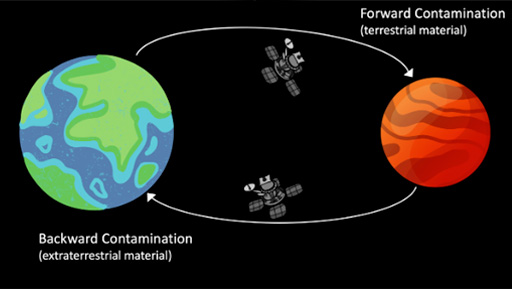3.3 The COPSAR Planetary Protection Policy
The COSPAR Planetary Protection Policy is a set of guidelines agreed upon internationally. Although it is not legally binding, it is considered the gold standard to which nations should aim within their own policies and strategies.
The Policy has two roles (summarised on Figure 19):
- ensure that scientific investigations of possible extra-terrestrial life forms, precursors, and remnants are not jeopardised
- Earth is protected from the potential hazard posed by extraterrestrial matter carried by spacecraft returning from an interplanetary mission.

The Policy consists of a list of categories that are dependent on the following:
- The type of mission. Is the mission a flyby, orbiter, or lander, or is it returning samples to Earth?
- The scientific objectives. Is the aim of the mission to find evidence of past or present life, or investigate prebiotic evolution?
- The target body. Does the target body potentially support growth, or do host environments have prebiotic potential?
-
Do you think a lander mission to Mars would have higher planetary protection requirements than a lander mission to the Moon?
-
The requirements for Mars would be higher. This is because we believe that the environmental conditions on Mars could have once been habitable and hold evidence of life.
The categories (Table 5) are important because they determine how stringent planetary protection controls need to be during the spacecraft design, build, launch and operations.
| Table 5 A simplified overview of the Planetary Protection categories | |||
|---|---|---|---|
| Category | Mission Type | Rationale | Target body (considered to date) |
| I | Flyby, orbiter, lander | Bodies that are not of direct interest for understanding chemical evolution and/or origin of life. | Asteroids that have experienced significant heating and melting; Io (moon of Jupiter) |
| II (divided into II, IIa and IIb for the Moon) | Flyby, orbiter, lander | Bodies that could have significance for the process of chemical evolution and/or origin of life, but where scientific judgement indicates remote possibility of contamination by organic or biological materials. | Venus, Moon, comets, carbon-rich asteroids, gas giant planets and some of their moons, some dwarf planets and Kuiper Belt Objects |
| III | Flyby, orbiter | Bodies that could have significance for the process of chemical evolution and/or origin of life, but where scientific judgement indicates significant possibility of contamination by organic or biological materials that could compromise future mission objectives. | Mars, Europa (moon of Jupiter), Enceladus (moon of Saturn) |
| IV (divided into a, b and c) | Lander | Bodies that could have significance for the process of chemical evolution and/or origin of life, but where scientific judgement indicates significant possibility of contamination by organic or biological materials that could compromise future mission objectives. | Mars, Europa, Enceladus |
| V ‘Restricted Earth Return’ | – | All Earth-return missions to protect the Earth-Moon system that scientific judgement indicates could have indigenous life. | Mars, Europa, Enceladus |
| V ‘Unrestricted Earth Return’ | – | All Earth-return missions from bodies that scientific judgement indicates will have no indigenous life. | Venus, Moon |
Activity 4
To understand how planetary protection plays a key part in developing missions, work through the following interactive that will show you the decisions that have to be taken to design and fly a space exploration mission. Space: to boldly, but cautiously, go. [Tip: hold Ctrl and click a link to open it in a new tab. (Hide tip)]
The interactive in Activity 4 introduced you to the importance of icy worlds in the search for life beyond Earth. The next section uses icy worlds as a case study to illustrate how the Planetary Protection Policy and its categories are applied.
